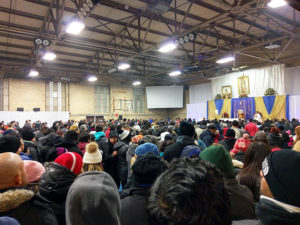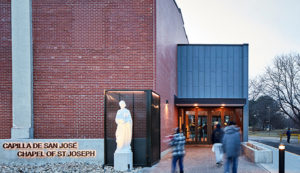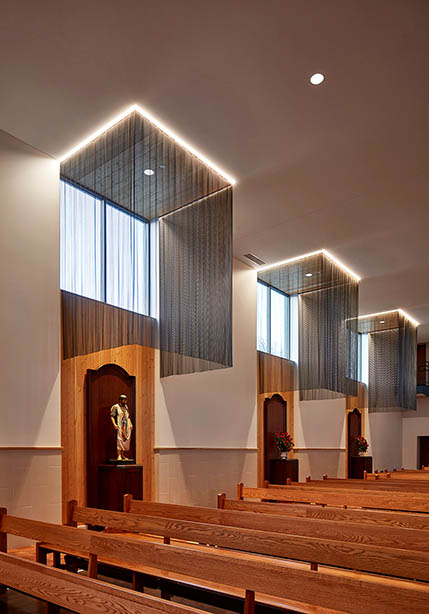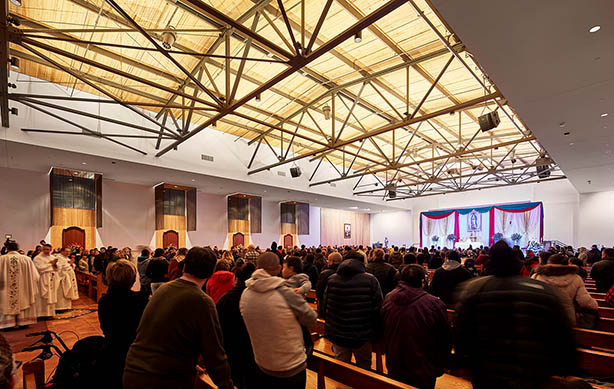There is a core belief in a “manda,” or pledge, to Our Lady of Guadalupe within the Latin American Catholic community. It involves asking Our Lady to intercede on the faithful’s behalf. Should a request be granted, the devotee must complete a spiritual pilgrimage to the Basilica of Our Lady of Guadalupe in Mexico City to honor their “manda.” This journey serves as a humble way of giving thanks, resulting in millions of people visiting the Basilica every year. Unfortunately, not all faithful followers can complete their pilgrimage to the Basilica due to myriad reasons. As a result, these followers struggle with an unfulfilled spiritual obligation.

The dark interior of the 1937 gym used as a shrine before the renovation. Photo: Tom Harris
After being officially declared a sister site to the Basilica in Mexico City in the late 1990s, the Shrine of Our Lady of Guadalupe in Des Plaines, Illinois offered Latino immigrants to the U.S. an alternative destination to fulfill their obligation. Consequently, the Shrine has experienced a continual rise in weekly worshippers and pilgrims visiting from the immigrant Latino community. In the late 1980s, locals established the Shrine with a grassroots effort on a 122-acre campus shared with Maryville Academy, a residential institution that has served children for over a century. However, after years of temporarily decorating a 1937 school gymnasium as a weekend worship space, Maryville Academy permanently ceded the gym to the Shrine. The result is a dedicated space for the Shrine reborn from the old gym as an exercise in adaptive re-use/repurpose.

Exterior of the renovated chapel. Photo: Tom Harris
The Latino community celebrates the Feast Day of Our Lady of Guadalupe each December 12th. In Mexico City, millions of worshippers fill the plaza and surrounding neighborhoods in a temperate climate for several days. In contrast, pilgrims traveling to Des Plaines typically endure freezing temperatures and driving snow, which does not deterred thousands of devotees who walk, bike, drive, or even ride on horseback in faithful groups from across the nation.
The year-round congregation at the Shrine recognized the extreme sacrifice that so many were offering to Our Lady. While holy images and a humble “Cerrito” (a hillside meant to resemble the holy site in Mexico City) provided some sense of spiritual fulfillment, they recognized the need to have a permanent space of worship worthy of that sacrifice. The congregation formed a building committee to repurpose the gymnasium as a dedicated Shrine chapel. The Committee held several meetings where they interviewed volunteer groups to determine the structure’s program. Groups came from the congregation, the surrounding neighborhood, and some represented pilgrims from across the nation.

Side chapels to various saints are created with lighting, wood paneling, and wire mesh curtains. Photo: Tom Harris
During the pilgrimage in 2018, the Archdiocese of Chicago inaugurated the Chapel of St. Joseph as the Shrine’s first year-round worship space. The design team, led by our firm (Wheeler Kearns Architects, Chicago), helped transform the old gym into the Shrine’s first climate-controlled, sacred, sheltered space for more than 6,000 weekly worshippers and over 300,000 pilgrims during December’s annual Feast of Our Lady of Guadalupe celebration.
More than 75 percent of the former gymnasium structure was reused: The original timber roof deck was exposed and the original riveted steel trusses were painted. A new glass and steel addition to the north, which inflects toward the Shrine, provides a fully accessible entry for visitors.
Upon entering, visitors encounter familiar materials and forms recalling traditional basilicas. Like early churches in the New World, the sacred space is constructed with humble materials: wood, metal, and clay, elevated by prismatic forms bathed in natural light. Side chapels–newly highlighted with gossamer canopies of wire mesh, warm wood paneling, and LED lighting–provide places of devotion for visitors of multiple cultures. While dedicated to St Joseph as a protector of the Virgin Mary, the chapel features saints from various cultures at each side chapel, reflecting an open invitation to pilgrims from all backgrounds. The design offsets the seating along the outside aisles at each side chapel to allow worshippers space to pray at the side chapels without interrupting ongoing services.
As is typical in traditional pilgrimage churches, the main altar is raised above the main floor for visibility. Unconventionally, the new rear wall behind the altar conceals two ramps that make both surrounding platforms accessible to aging priests and parishioners alike. A new skylight, positioned above the altar, casts natural light on the altar–a universally understood design feature highlighting the most sacred place in the nave.

Newly exposed ceiling is illuminated with up-lights. Photo: Tom Harris
The new chapel resulted from the efforts of a caring community determined to make the best use of its available resources to elevate the spiritual experience of visiting pilgrims. Before the renovation, the parishioners casually referred to the space as “El Gym.” However, after the Inaugural Mass that honored this “new” Shrine, they now refer to the space as the “La Capilla de San Jose.” In several ways, the Chapel of St Joseph is a pledge of its own, the fulfillment of a promise, not only to Our Lady of Guadalupe but to its community, proving that a small group of people can make a global impact.

